Shortwave Infrared (SWIR) Market Size, Share & Industry Trends Growth Analysis Report by Camera, Lenses, Spectral Imaging, Area & Line Scan, Active & Passive Thermal Imaging, Pushbroom, Snapshot, Security & Surveillance, Monitoring & Inspection, Technology, Vertical and Region – Global Forecast to 2029
Updated on : Oct 22, 2024
The global shortwave infrared (SWIR) market size is estimated to be valued at USD 631 million in 2024 and is projected to reach USD 1,068 million by 2029, growing at a CAGR of 11.1% from 2024 to 2029.
Based on imaging type, the SWIR industry is segmented into spectral, thermal, and hyperspectral imaging. Spectral imaging is widely used in many applications due to its InGaAs sensors, which are widely available in the market.
SWIR offers superior imaging details for applications such as semiconductor inspection, fruit ripeness monitoring, and surveillance, among others. Hence, it is increasingly used in various emerging applications. The development of more affordable, user-friendly SWIR systems also supports the growth of the market. The potential application of SWIR in consumer electronics is also expected to drive market growth in the near future.
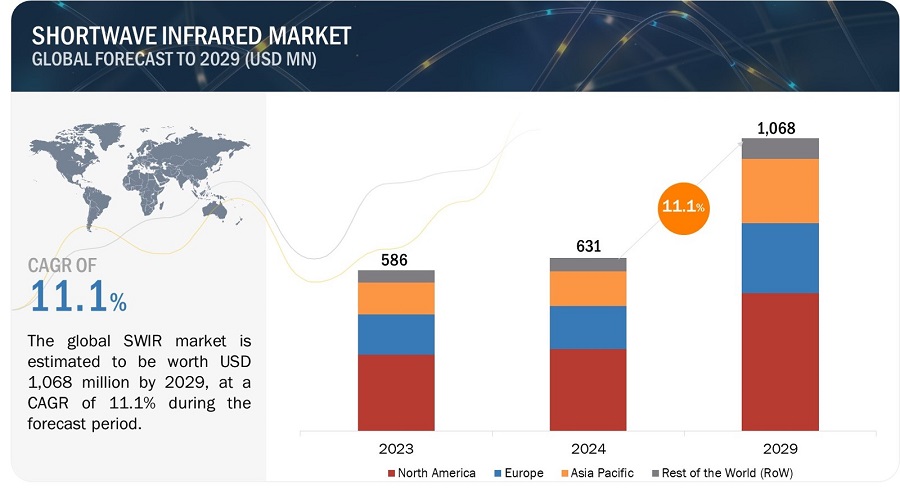

Shortwave Infrared (SWIR) Market Forecast to 2029
To know about the assumptions considered for the study, Request for Free Sample Report
AI Impact in SWIR Market
Integrating AI algorithms with SWIR technology has enhanced accuracy, speed, efficiency, and adoption in various applications. According to a recent International Association for Pattern Recognition (IAPR) report, AI-powered imaging systems have revolutionized multiple sectors, including healthcare, agriculture, and security.
The incorporation of AI in SWIR systems has brought forward newer applications and use cases such as Advanced Driver Assistance Systems (ADAS), 3D sensing, hydration monitoring, bruise detection and ripeness monitoring, and non-invasive diagnostics, among others.
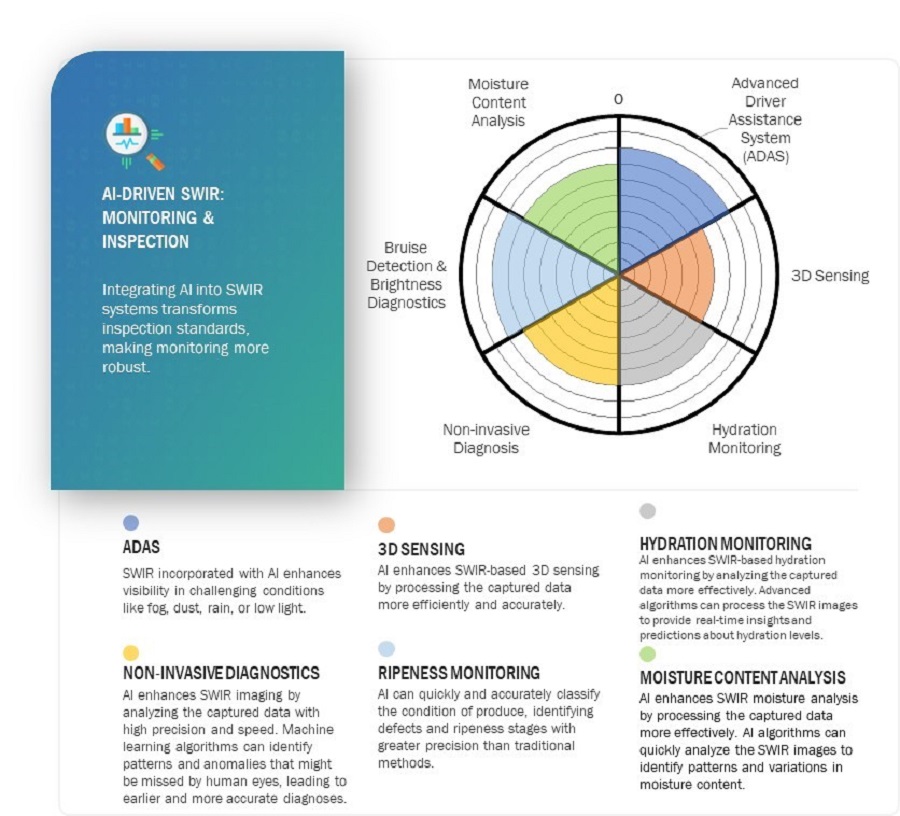
Shortwave Infrared (SWIR) Market Trends
Driver: Enhanced vision and 3D sensing by SWIR in automotive vertical
SWIR has enhanced vision and 3D sensing capabilities, thereby increasing visibility in low-light conditions and enhancing driver safety. Its high-resolution imaging supports ADAS (Advanced Driver Assistance Systems) in identifying objects with great precision. SWIR also has the ability to see through materials and detect thermal differences, which aids in understanding vehicle surroundings. This integration of 3D sensing and enhanced vision in the automotive sector is expected to drive market growth for SWIR systems.
Restraint: Less signal-to-noise ratio in SWIR imagers
A lower signal-to-noise ratio in images makes it hard to understand the fine details and reduces image quality and clarity. The signal-to-noise ratio in a SWIR imager makes a huge difference in seeing and not seeing an object in question. In SWIR, achieving a higher signal-to-noise ratio is important as it impacts the accuracy and output of information captured by the imagers. Improvements in signal-to-noise ratio are crucial for clearer images and more reliable outputs.
Opportunity: Use in disaster management and response
SWIR is useful in disaster management and response because of its ability to see through smoke, fog, dust, and certain materials, which are highly likely to block the view of emergency response personnel during disaster management operations. SWIR can provide clear images in low light conditions, helping emergency personnel to rescue individuals and assess damage in challenging environments. These cameras can also detect temperature variations, identifying hotspots in fires, among other disasters.
Challenge: Fundamental limits of FOV (Field of Vision)
The camera's FOV determines how much of the scene can be captured simultaneously. For SWIR cameras, expanding the FOV can be challenging due to limitations in optics, sensor design, and system architectures. A wide FOV is desirable when capturing big areas; however, the resolution is compromised, or system complexity is highly increased.
SWIR Market Ecosystem
The leading players operating in the SWIR market are Teledyne FLIR LLC (US), Leonardo DRS (US), Corning Incorporated (US), Allied Vision Technologies GmbH (Germany), and Collins Aerospace (US), among others.
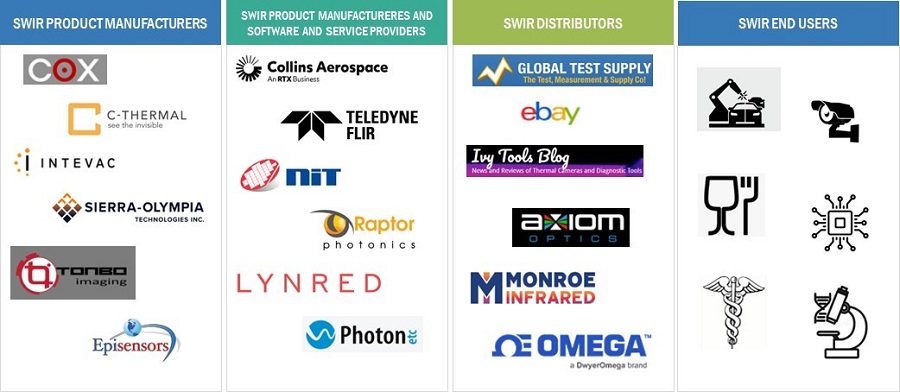
Shortwave Infrared (SWIR) Market Segment
Monitoring & inspection segment to exhibit highest CAGR during forecast period.
The monitoring & inspection segment is anticipated to register the highest CAGR during the forecast period. The SWIR technology provides images even in challenging conditions of low light and dust, and hence has universal applicability.
In most applications, industries are applying SWIR cameras to quality control and maintenance, as it is capable of finding the defects and problems that are impossible to detect with other imaging technologies. Factors such as enhanced visibility, technological advancements, and versatility in penetration through materials like plastic and fabrics are the growth of the market for this segment. SWIR systems are crucial in food & beverages, semiconductor wafer inspection, and automotive applications, among others. SWIR also has significant potential applications in consumer electronics.
Cooled SWIR to register high growth during forecast period.
Cooled SWIR imagers provide superior sensitivity, higher resolution, and better performance in low light and challenging circumstances, making them ideal for monitoring & inspection and surveillance where temperature differences might occur.
Critical applications for these cameras are in security & surveillance, and industrial inspection, where accuracy and reliability are the main players. The integration of the next-generation cooling technologies that will make these cameras more efficient and affordable will drive further adoption. Technological advancements are also making cooled SWIR imagers affordable, which is expected to fuel the market growth.
Spectral imaging to be fastest-growing type in SWIR market.
Spectral Imaging offers a close insight into materials and their compilation. It acquires data through various wavelengths, subsequently enabling the discovery and examination of materials with discrepancies, making it valuable in applications such as food & beverages, environmental monitoring, and medical research, among others.
With increasing superior accuracy and insights acquired through spectral imaging than conventional methods of imaging, it is becoming a tool for various industries from agriculture to environmental monitoring and security. Improvements to technology make SWIR affordable to be used in various industries. Increased demand for data-rich imaging fuels the fastest growth of spectral imaging in the SWIR market.
Shortwave Infrared (SWIR) Market Regional Analysis
Asia Pacific to register CAGR in SWIR market during the forecast period.
The Asia Pacific region is projected to register the highest CAGR in the SWIR market. The high growth of the market is attributed to rapid industrialization, primarily in China, Japan, and South Korea. The region is a major base for electronics, automotive, and semiconductor manufacturers.
Hence, there is a high demand for monitoring & inspection solutions for production and testing purposes in the electronics, automotive, and semiconductor sectors. Moreover, high spending on research and development and supportive government policies and programs regarding the application of advanced manufacturing technologies are also supporting the growth of the SWIR market in this region.
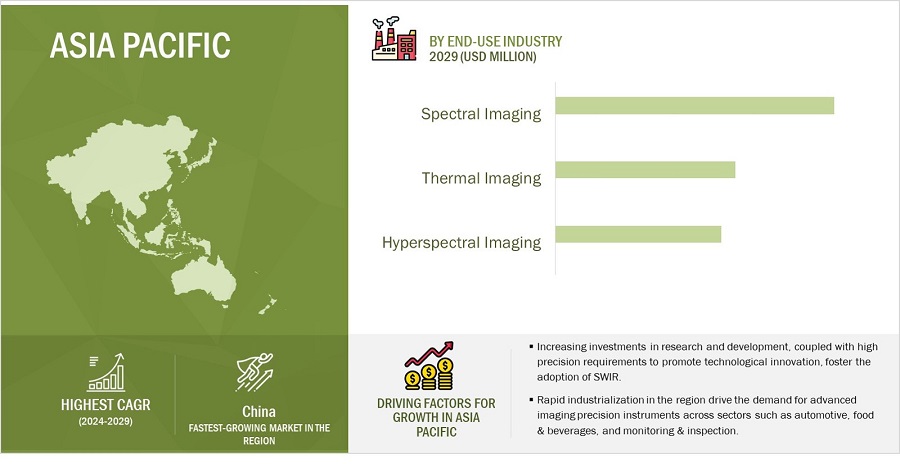
Shortwave Infrared (SWIR) Market by Region
To know about the assumptions considered for the study, download the pdf brochure
Top Shortwave Infrared (SWIR) Companies - Key Market Players
The SWIR companies is dominated by players such as
- Teledyne FLIR (US),
- Collins Aerospace (US),
- Leonardo DRS (US),
- Allied Vision Technologies (Germany), and
- Corning Incorporated (US), among others.
Shortwave Infrared (SWIR) Report Scope
|
Report Metric |
Details |
| Estimated Shortwave Infrared (SWIR) Market Size | USD 631 million in 2024 |
| Projected Market Size | USD 1,068 million by 2029 |
| Growth Rate | CAGR of 11.1% |
|
Shortwave Infrared (SWIR) Market size available for years |
2020-2029 |
|
Base year considered |
2023 |
|
Forecast period |
2024-2029 |
|
Forecast units |
Value (USD Million/Billion) |
|
Segments covered |
By Imaging Type, By Offering, By Technology, By Use-case, By Vertical, and by Region |
|
Geographies covered |
North America, Europe, Asia Pacific, and Rest of the World (RoW) |
|
Companies covered |
Major players operating in the SWIR market are Teledyne FLIR LLC (US), Corning Incorporated (US), Collins Aerospace (US), Allied Vision Technologies GmbH (Germany), and Leonardo DRS (US), among others. (A total of 25 players have been profiled) |
Shortwave Infrared (SWIR) Highlights
The study categorizes the SWIR market based on the following segments:
|
Segment |
Subsegment |
|
By Imaging Type |
|
|
By Offering |
|
|
By Technology |
|
|
By Use-case |
|
|
By Vertical |
|
|
By Region |
|
Recent Developments in Shortwave Infrared (SWIR) Industry
- In May 2024, Teledyne FLIR LLC announced a partnership with UE Systems Inc. (US) through which the company aims to provide industrial customers with advanced predictive maintenance solutions. This collaboration will combine Teledyne's thermal imaging systems with UE system's ultrasonic technology.
- In December 2021, Allied Vision Technologies GmbH (Germany) launched Alvium 1800 (SWIR Camera), which was made available with Sony's innovate InGaAs SWIR sensors.
- In September 2023, Leonardo DRS (US) launched Small Unmanned Aircraft System Tactical Agile Gimbal (STAG)-5 LLD gimbal which offers high-definition day and night imaging for small, unmanned aircraft. It is lightweight, highly stable, and integrates advanced sensors for superior performance in military operations.
Frequently Asked Questions:
What are the SWIR market's major driving factors and opportunities?
The SWIR market has emerging applications due to the superior penetration and details offered by different SWIR systems. The development of more affordable and user-friendly SWIR is one of the drivers of the SWIR market.
Which region is expected to hold the highest market share?
North America commands a large share of the SWIR market. The expanding SWIR sector and industry demands are driving the adoption of SWIR in the North American market. However, increasing funding for R&D focused on enhancing the analytical capabilities of SWIR facilitates the high growth of SWIR solutions in the Asia Pacific region.
Who are the leading players in the global SWIR market?
Companies such as Teledyne FLIR LLC (US), Leonardo DRS (US), Corning Incorporated (US), Allied Vision Technologies GmbH (Germany), and Collins Aerospace (US) are some of the leading players in the global SWIR market.
What are some of the technological advancements in the market?
What is the size of the global SWIR market?
The global SWIR market is valued at USD 631 million in 2024 and is anticipated to reach USD 1,068 million by 2029, at a CAGR of 11.1% during the forecast period.
To speak to our analyst for a discussion on the above findings, click Speak to Analyst

The study involved four major activities in estimating the current size of the SWIR market. Exhaustive secondary research was done to collect information on the market, peer, and parent markets. The next step was to validate these findings, assumptions, and sizing with industry experts across the value chain through primary research. Both top-down and bottom-up approaches were employed to estimate the complete market size. After that, market breakdown and data triangulation were used to estimate the market size of segments and subsegments.
Secondary Research
Various secondary sources have been referred to in the secondary research process to identify and collect information important for this study. The secondary sources include annual reports, press releases, and investor presentations of companies; white papers; journals and certified publications; and articles from recognized authors, websites, directories, and databases. Secondary research has been conducted to obtain critical information about the industry’s supply chain, the market’s value chain, the total pool of key players, market segmentation according to the industry trends (to the bottom-most level), regional markets, and key developments from market- and technology-oriented perspectives. The secondary data has been collected and analyzed to determine the overall market size, further validated by primary research.
List of major secondary sources
|
Sources |
Web Link |
|
Company Blogs |
|
|
Industry Journals |
|
|
Environmental Protection Agency |
Primary Research
Extensive primary research was conducted after gaining knowledge about the current scenario of the SWIR market through secondary research. Several primary interviews were conducted with experts from the demand and supply sides across four major regions—North America, Europe, Asia Pacific, and RoW. This primary data was collected through questionnaires, emails, and telephonic interviews.
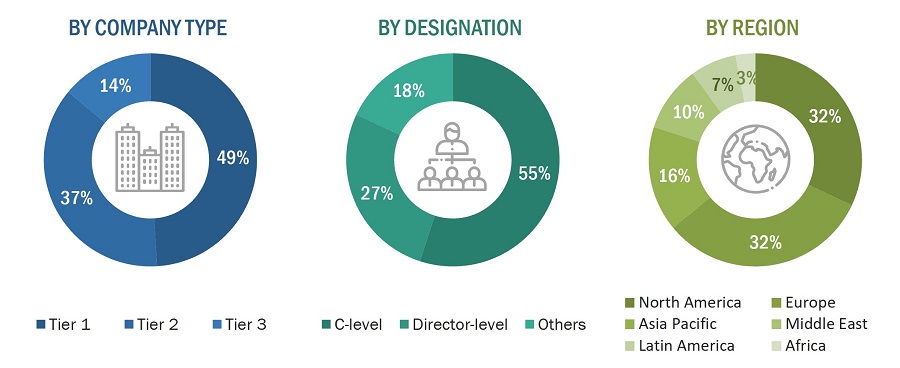
To know about the assumptions considered for the study, download the pdf brochure
Market Size Estimation
In the complete market engineering process, top-down and bottom-up approaches and several data triangulation methods have been used to estimate and forecast the overall market segments and subsegments listed in this report. Key players in the market have been identified through secondary research, and their market shares in the respective regions have been determined through primary and secondary research. This entire procedure includes the study of annual and financial reports of the top market players and extensive interviews for key insights (quantitative and qualitative) with industry experts (CEOs, VPs, directors, and marketing executives).
All percentage shares, splits, and breakdowns have been determined using secondary sources and verified through primary sources. All the parameters affecting the markets covered in this research study have been accounted for, viewed in detail, verified through primary research, and analyzed to obtain the final quantitative and qualitative data. This data has been consolidated and supplemented with detailed inputs and analysis from MarketsandMarkets and presented in this report. The following figure represents this study’s overall market size estimation process.
Bottom-Up Approach
- Identifying various applications of SWIR
- Analyzing the penetration of each type of SWIR technology through secondary and primary research
- Analyzing the penetration of SWIR for different applications and verticals through secondary and primary research
- Conducting multiple discussion sessions with key opinion leaders to understand the detailed working of SWIR and their implementation in numerous applications; this helped analyze the break-up of the scope of work carried out by each major company
- Verifying and cross-checking the estimates at every level with key opinion leaders, including CEOs, directors, operation managers, and finally with MarketsandMarkets domain experts
- Studying various paid and unpaid sources of information, such as annual reports, press releases, white papers, and databases

Top-Down Approach
- Focusing initially on the top-line investments and expenditures being made in the ecosystem of the SWIR market; further, splitting the key market areas based on imaging type, offering, technology, use case, vertical, and region, and listing the key developments
- Identifying all leading players and applications in the SWIR market based on region through secondary research and thoroughly verifying them through a brief discussion with industry experts
- Analyzing revenues, product mix, geographic presence, and key applications served by all identified players to estimate and arrive at percentage splits for all key segments
- Discussing splits with the industry experts to validate the information and identify key growth pockets across all key segments
- Breaking down the total market based on verified splits and key growth pockets across all segments

Data Triangulation
After arriving at the overall market size from the estimation process explained in the previous section, the total market was split into several segments and subsegments. The data triangulation procedure was employed, wherever applicable, to complete the overall market engineering process and arrive at the exact statistics for all segments and subsegments. The data was triangulated by studying various factors and trends from the demand and supply sides, and the market size was validated using top-down and bottom-up approaches.
Market Definition
Short Wave IR (SWIR) is a subset of the infrared band in the electromagnetic spectrum, covering wavelengths ranging from 1 to 3 microns. This wavelength is not visible to human eyes and can often offer a better image than what is achievable with visible light imaging. A number of manufacturers make SWIR imagers that detect various ranges of the electromagnetic spectrum with multiple qualities.
For imaging in this range, SWIR cameras convert the radiation of objects in the SWIR range to a measurable form. The capability of a SWIR camera depends on the type of component used. Lenses and detectors are the two most essential components of a SWIR camera and account for a significant percentage of the total parts of a SWIR camera. Indium gallium arsenide (InGaAs), mercury cadmium telluride (HgCdTe), and indium antimonide (InSb) are a few of the types of SWIR detectors available in the SWIR market.
Key Stakeholders
- SWIR material and component providers
- SWIR providers, integrators, and installers
- Electronic hardware equipment manufacturers
- Optical system manufacturers
- SWIR software and solution providers
- Consulting companies
- SWIR related associations, organizations, forums, and alliances
- Government and corporate bodies
- Research institutes and organizations
- Venture capitalists, private equity firms, and startup companies
- Distributors and traders
- Original equipment manufacturers (OEMs)
- End users
Report Objectives
- To define, describe, and forecast the SWIR market in terms of value, segmented by imaging type, by offering, by technology, use case, and vertical
- To describe and forecast the market, in terms of value, for various segments with respect to four main regions—North America, Europe, Asia Pacific, and Rest of the World (RoW)
- To study different types of materials used in SWIR products with the scope limited to qualitative research only
- To forecast the SWIR market in terms of volume
- To provide detailed information regarding the major factors, such as drivers, restraints, opportunities, and challenges, influencing the growth of the SWIR market
- To strategically analyze micromarkets1 with respect to individual growth trends, prospects, and contributions to the total market
- To analyze opportunities for stakeholders by identifying high-growth segments of the SWIR market
- To benchmark players within the market using the proprietary Company Evaluation Matrix framework, which analyzes market players on various parameters within the broad categories of market rank and product offering
- To strategically profile the key players and comprehensively analyze their market shares and core competencies2 and provide a detailed competitive landscape for market leaders
- To analyze competitive developments, such as partnerships, collaborations, agreements, and joint ventures; mergers and acquisitions; expansions; and product launches and developments; in the SWIR market
Customization Options
With the given market data, MarketsandMarkets offers customizations according to the company’s specific needs. The following customization options are available for the report:
Company Information
- Detailed analysis and profiling of additional market players (up to five)
Geographic Analysis
- Further breakdown of regions into respective countries



 Generating Response ...
Generating Response ...











Growth opportunities and latent adjacency in Shortwave Infrared (SWIR) Market